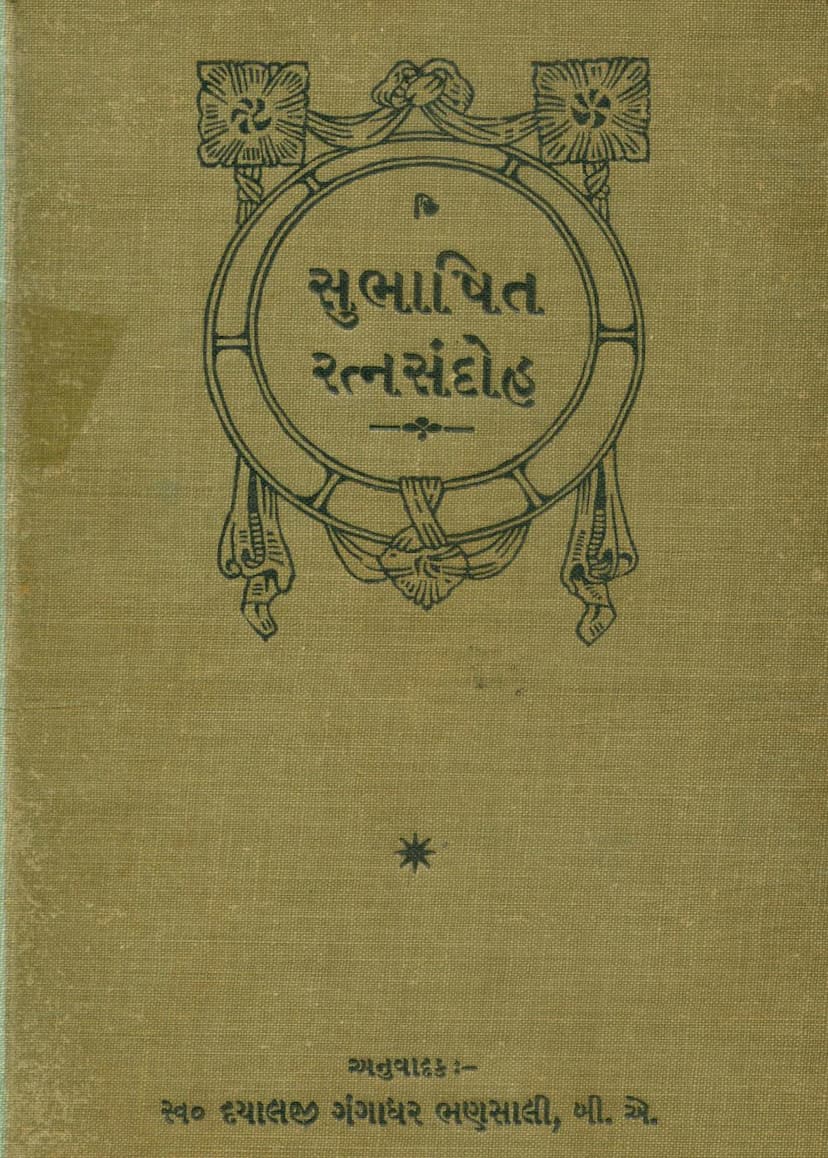Subhashit Ratnasandoh
Added to library: September 2, 2025

Summary
Here is a comprehensive summary of the Jain text "Subhashit Ratnasandoh," based on the provided Gujarati text:
Book Title: Subhashit Ratnasandoh Author: Acharya Amitagati (Original) / Late Dayal Gangadhar Bhansali (Translator) Publisher: Hirji Gangadhar Bhansali
Overview:
"Subhashit Ratnasandoh" is a collection of wise sayings and verses compiled by the renowned Jain Acharya Amitagati. The book, translated into Gujarati by the late Dayal Gangadhar Bhansali, aims to provide profound spiritual and moral guidance to the reader. It covers a wide spectrum of Jain philosophy, ethics, and conduct, presented in a clear and accessible manner.
Key Sections and Themes:
The book is structured into numerous chapters, each dedicated to specific aspects of spiritual and ethical living. Some of the prominent themes and chapters include:
-
Subhashit Ratnasandoh (Wise Sayings): The core of the book consists of subhashitas – aphorisms and verses that encapsulate universal truths and ethical principles. These sayings are designed to inspire contemplation and reflection on the nature of life, the self, and the path to liberation.
-
Discrimination between the Real and the Unreal (Sat-Asat Swaroop Nirupan): This section delves into the understanding of what is truly permanent and what is transient in the world. It guides the reader to discern between the eternal soul and the perishable material world.
-
Praise of Jain Principles (Jain Tatva): The text emphasizes the core tenets of Jainism, such as ahimsa (non-violence), satya (truthfulness), asteya (non-stealing), brahmacharya (celibacy), and aparigraha (non-possession). It explains how adherence to these principles leads to spiritual purification.
-
Conduct and Ethics (Achara): The book details the conduct expected of both ascetics (sadhus) and lay followers (shravakas). It outlines the rules and responsibilities associated with each stage of spiritual practice.
-
The Nature of the Soul (Jiva Sambodhan): A significant portion of the text is dedicated to understanding the true nature of the soul, its inherent purity, and its journey through various life forms.
-
Renunciation of Worldly Pleasures: The verses repeatedly highlight the impermanence of worldly pleasures and the attachments that bind the soul to the cycle of birth and death. It encourages detachment and the pursuit of spiritual happiness.
-
The Dangers of Anger, Greed, and Pride: The text elaborates on the destructive nature of negative emotions like anger (kopa), greed (lobha), and pride (mana), illustrating how they hinder spiritual progress.
-
The Importance of Knowledge and Conduct: It stresses that mere intellectual knowledge (jnana) is insufficient without right conduct (charitra) and right faith (darshan). The combination of these three – the "Triple Jewels" – is presented as the path to liberation.
-
The Impermanence of Life and the Body: The book repeatedly reminds the reader of the fleeting nature of life, youth, health, wealth, and relationships, urging them to focus on spiritual pursuits before death overtakes them.
-
The Role of Virtue: Virtues such as truthfulness, non-violence, forgiveness, contentment, and self-control are presented as essential for spiritual growth and well-being.
-
The Path to Liberation (Moksha): Ultimately, the Subhashit Ratnasandoh guides the reader towards the ultimate goal in Jainism – Moksha (liberation from the cycle of rebirth). It emphasizes that through right knowledge, right faith, and right conduct, coupled with austerity and detachment, this goal can be achieved.
Translator's Contribution:
Dayal Gangadhar Bhansali, the translator, has rendered the original Sanskrit verses into Gujarati, making the profound wisdom of Acharya Amitagati accessible to a wider audience. The preface and biographical notes within the text highlight Bhansali's dedication to this translation, which he undertook as a meaningful endeavor. Sadly, he passed away before its full publication, and the work was completed and published by his brother, Hirji Gangadhar Bhansali.
Author's Background:
Acharya Amitagati, the original author, was a distinguished Jain scholar and poet who lived during the reign of King Munja in the Malwa region. His literary contributions are significant, and this work is considered one of his important compositions, alongside "Dharma Pariksha" and "Shravakacharya." The text mentions that "Subhashit Ratnasandoh" was composed in Vikram Samvat 1050.
Overall Message:
The "Subhashit Ratnasandoh" serves as a spiritual guide, encouraging readers to live a life of virtue, self-discipline, and detachment. It emphasizes the ephemeral nature of worldly existence and the ultimate importance of spiritual realization and liberation. The verses are both profound and practical, offering timeless wisdom for navigating life's challenges and achieving spiritual fulfillment.